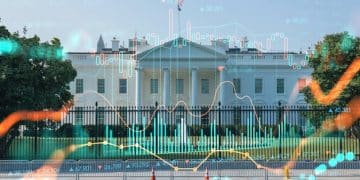Inflation Rate Steady at 3.5%: Factors and Projections for US Economy

The inflation rate in the US has remained stable at 3.5% for the third consecutive month, prompting analysis of key economic factors such as energy prices, supply chain dynamics, and Federal Reserve policies, while future projections vary depending on these influences.
The **inflation rate remains steady at 3.5% for the third consecutive month** in the United States, sparking debates among economists and policymakers. What factors are contributing to this persistent rate, and what does it mean for the future of the US economy?
Understanding the Current Inflation Landscape
The US economy is currently navigating a complex period with inflation rates holding steady. Understanding the underlying economic forces is essential for consumers, businesses, and investors to make informed decisions.
Key Economic Indicators
Several key indicators provide insights into the current inflation landscape. These include:
- Consumer Price Index (CPI): Measures the average change over time in the prices paid by urban consumers for a basket of consumer goods and services.
- Producer Price Index (PPI): Measures the average change over time in the selling prices received by domestic producers for their output.
- Employment Rate: The percentage of the labor force that is employed, which can influence wage levels and overall demand.
- Gross Domestic Product (GDP): The total value of goods and services produced in the United States, reflecting economic growth or contraction.
Analyzing these indicators helps economists and policymakers assess the current state of the economy and predict future trends.
Moreover, the current inflation rate is influenced by a mix of supply-side and demand-side factors. Supply chain disruptions, energy prices, and labor shortages contribute to cost-push inflation, while strong consumer demand drives demand-pull inflation. The interplay of these factors determines the overall inflation rate and its persistence.
In conclusion, understanding the current inflation landscape requires a comprehensive analysis of key economic indicators and the interplay of supply and demand-side factors. This provides a foundation for anticipating future economic trends and making informed financial decisions.
Factors Contributing to the 3.5% Inflation Rate
Several factors are contributing to the ongoing inflation rate of 3.5%. These include energy prices, supply chain dynamics, and the Federal Reserve’s monetary policies.

Energy Prices
Energy prices play a significant role in inflation. Fluctuations in oil and gas prices can directly affect the cost of transportation, manufacturing, and consumer goods.
- Geopolitical Tensions: Conflicts and instability in oil-producing regions can lead to supply disruptions and price spikes.
- Seasonal Demand: Increased demand during peak seasons, such as summer driving and winter heating, can drive up energy prices.
- Production Cuts: Decisions by major oil-producing countries to reduce output can tighten supply and raise prices.
Monitoring energy prices is crucial for forecasting inflation trends.
Supply Chain Dynamics
Supply chain disruptions can lead to shortages of goods and increased prices. These disruptions can be caused by various factors, including:
- Pandemics: Outbreaks of infectious diseases can shut down factories and disrupt transportation networks.
- Natural Disasters: Hurricanes, earthquakes, and other natural disasters can damage infrastructure and disrupt supply chains.
- Trade Policies: Tariffs and trade restrictions can increase the cost of imported goods.
Addressing supply chain bottlenecks is essential for controlling inflation.
The Federal Reserve’s monetary policies also impact inflation. By adjusting interest rates and the money supply, the Fed aims to maintain price stability and full employment. Lower interest rates can stimulate economic growth and increase demand, potentially leading to higher inflation. Conversely, higher interest rates can cool down the economy and reduce inflation.
The Federal Reserve’s actions are closely watched by economists and investors, as they can significantly impact the direction of the economy and inflation rates.
In conclusion, the 3.5% inflation rate is influenced by a complex interplay of energy prices, supply chain dynamics, and Federal Reserve policies. These factors must be carefully monitored and managed to ensure a stable and healthy economy.
Impact on Consumers and Businesses
The current inflation rate has significant implications for consumers and businesses. Understanding these impacts is crucial for making informed financial decisions.
Consumer Spending
Inflation can erode purchasing power, making it more expensive for consumers to buy goods and services. This can lead to:
- Reduced Discretionary Spending: Consumers may cut back on non-essential purchases, such as travel and entertainment.
- Increased Debt: Households may rely more on credit cards and loans to cover essential expenses.
- Shift in Consumption Patterns: Consumers may switch to cheaper brands or delay purchases.
Consumers need to be strategic about their spending habits in an inflationary environment.
Business Operations
Businesses face several challenges in an inflationary environment, including:
- Rising Input Costs: The cost of raw materials, labor, and transportation may increase.
- Pricing Strategies: Businesses must decide whether to absorb the higher costs or pass them on to consumers.
- Investment Decisions: Inflation can create uncertainty and make it more difficult for businesses to plan for the future.
Businesses need to adapt their strategies to navigate the challenges of inflation.

Furthermore, the impact of inflation can vary across different sectors of the economy. Industries that are heavily reliant on imported goods or energy may be more vulnerable to inflationary pressures. Businesses need to carefully assess their exposure to inflation and develop strategies to mitigate its impact.
Overall, the current inflation rate poses challenges for both consumers and businesses. By understanding these impacts and adapting their strategies, individuals and companies can navigate the inflationary environment more effectively.
Federal Reserve’s Response and Monetary Policy
The Federal Reserve plays a crucial role in managing inflation through its monetary policies. Understanding these policies is essential for anticipating future economic trends.
Tools for Managing Inflation
The Federal Reserve has several tools at its disposal for managing inflation, including:
- Interest Rate Adjustments: Raising or lowering the federal funds rate can influence borrowing costs and economic activity.
- Open Market Operations: Buying or selling government securities to increase or decrease the money supply.
- Reserve Requirements: Setting the percentage of deposits that banks must hold in reserve.
These tools allow the Fed to control inflation and maintain price stability.
Recent Policy Decisions
In response to the current inflation rate, the Federal Reserve has taken several steps, such as:
- Raising Interest Rates: The Fed has increased the federal funds rate to cool down the economy and reduce inflation.
- Quantitative Tightening: The Fed has reduced its holdings of government securities to decrease the money supply.
- Forward Guidance: The Fed has communicated its intentions to continue tightening monetary policy until inflation is brought under control.
These policy decisions reflect the Fed’s commitment to managing inflation risks.
Looking ahead, the Federal Reserve is expected to continue monitoring inflation and adjusting its policies as needed. The Fed’s actions will depend on a variety of factors, including economic growth, employment, and global economic conditions. Investors and businesses need to stay informed about the Federal Reserve’s policy decisions to make informed financial decisions.
In summary, the Federal Reserve’s response and monetary policy are critical for managing inflation and maintaining a stable economy. By understanding the Fed’s tools and policy decisions, individuals and businesses can better anticipate future economic trends.
Expert Opinions and Economic Forecasts
Expert opinions and economic forecasts provide valuable insights into the future trajectory of inflation. Considering these perspectives can help individuals and businesses make informed decisions.
Differing Perspectives
Economists hold differing views on the future of inflation. Some believe that the current inflation rate is temporary and will eventually subside as supply chain disruptions ease. Others fear that inflation could become entrenched and require more aggressive action by the Federal Reserve.
Analyzing these differing perspectives can provide a more nuanced understanding of the economic outlook.
- Hawkish Views: Economists who believe that inflation is a serious threat and requires aggressive action by the Fed.
- Dovish Views: Economists who believe that inflation is temporary and that the Fed should be cautious about raising interest rates too quickly.
- Neutral Views: Economists who believe that the Fed should take a balanced approach and monitor the situation closely.
Future Projections
Economic forecasts vary depending on the assumptions used and the models employed. However, most forecasts suggest that inflation will gradually decline over the next few years. Factors that could influence the accuracy of these forecasts include:
- Unexpected Economic Shocks: Unforeseen events, such as pandemics or geopolitical conflicts, can disrupt the economic outlook.
- Policy Changes: Changes in government policies, such as tax cuts or spending increases, can impact inflation.
- Global Economic Conditions: Slowdowns or recessions in other countries can affect the US economy and inflation rates.
Staying informed about economic forecasts and expert opinions is crucial for making informed financial decisions.
In conclusion, expert opinions and economic forecasts offer valuable insights into the future trajectory of inflation. By considering these perspectives and staying informed about potential risks and uncertainties, individuals and businesses can better prepare for the future.
Strategies for Managing Inflation Risks
Given the uncertainties surrounding inflation, it is essential to develop strategies for managing inflation risks. These strategies can help individuals and businesses protect their financial well-being.
For Consumers
Consumers can take several steps to manage inflation risks, including:
- Budgeting and Savings: Creating a budget and tracking expenses can help consumers identify areas where they can cut back on spending.
- Investing in Inflation-Protected Securities: Treasury Inflation-Protected Securities (TIPS) can help protect savings from inflation.
- Negotiating Better Deals: Consumers can shop around for better deals on insurance, utilities, and other expenses.
Implementing these strategies can help consumers mitigate the impact of inflation on their finances.
For Businesses
Businesses can also take steps to manage inflation risks, such as:
- Hedging Against Inflation: Businesses can use financial instruments, such as futures and options, to hedge against rising input costs.
- Improving Efficiency: Streamlining operations and reducing waste can help businesses lower their costs.
- Diversifying Supply Chains: Relying on multiple suppliers can help businesses mitigate the impact of supply chain disruptions.
By implementing these strategies, businesses can navigate the challenges of inflation more effectively.
Moreover, both consumers and businesses should consider seeking professional advice from financial advisors or consultants. These experts can provide tailored guidance and help individuals and companies develop strategies that are best suited to their specific needs and circumstances.
In summary, managing inflation risks requires a proactive and strategic approach. By implementing the strategies outlined above and seeking professional advice, individuals and businesses can protect their financial well-being in an inflationary environment.
| Key Point | Brief Description |
|---|---|
| 📊 Inflation Rate | Stays steady at 3.5% for three months. |
| ⛽ Energy Prices | Geopolitical tensions and seasonal demand affect prices. |
| 🚚 Supply Chains | Disruptions lead to shortages and increased prices. |
| 🏦 Fed Policy | Adjusts interest rates to control inflation. |
Frequently Asked Questions (FAQ)
▼
A 3.5% inflation rate means that the cost of goods and services is increasing by 3.5% annually. This can reduce purchasing power, especially for those on fixed incomes, making it harder to afford everyday expenses.
▼
The inflation rate is calculated using the Consumer Price Index (CPI), which measures the average change in prices paid by urban consumers for a market basket of consumer goods and services over time.
▼
The Federal Reserve can lower inflation by raising interest rates, reducing the money supply, and implementing quantitative tightening. These measures aim to cool down the economy and reduce demand.
▼
Supply chain issues can lead to shortages of goods, which in turn drives up prices. When demand exceeds supply, businesses can charge more for their products, contributing to inflation.
▼
Treasury Inflation-Protected Securities (TIPS) are bonds that are indexed to inflation. They are designed to protect investors from the erosion of purchasing power caused by inflation by adjusting their principal value based on the CPI.
Conclusion
In conclusion, the steady inflation rate of 3.5% reflects a complex interplay of economic factors, including energy prices, supply chain dynamics, and Federal Reserve policies. Understanding these factors and implementing strategies to manage inflation risks are essential for consumers and businesses alike in navigating the current economic landscape.





